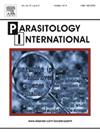Systemic infection of Prohemistomum vivax and Cyanodiplostomum encysted metacercariae in African catfish (Clarias gariepinus) from a heavily polluted drain at Giza, Egypt: morphological, molecular and histopathological study
IF 1.9
4区 医学
Q3 PARASITOLOGY
引用次数: 0
Abstract
Aquatic environmental pollution could be a direct trigger of infection through cercarial invasion to skin / gills or indirectly as a predisposing factor that damage the physical barriers of targeted fish resulting in high intensities of EMC infections in all fish vital organs. In the current study, a total of 150 African catfish (Clarias gariepinus) were randomly collected from Mariotteya drain all the way through the Egyptian township of Shabramant located at the historical heart of Giza. Catfish samples were collected in mid-summer during the period from June to July 2024. A well-documented surge in unionized ammonia, water alkalinity, marked decline in dissolved oxygen together with decreased transparency were signaling a chronic case of agricultural and municipal pollution in which all physical mucosal immunological barriers were harshly suppressed. This environmental disruption has resulted in cellular, biological and pathological alterations in which the invasion of digenean cercariae was favored as documented in the histopathological sections made from affected tissues. Parasitological examination revealed the presence of two distinct EMC belonging to Prohemistomum vivax and Cyanodiplostomum spp. which were presumptively identified using the regular morpho-taxonomical methods and confirmed utilizing the sequencing of the ITS2 rDNA gene which is considered good marker in the differentiation between the digenean species and the phylogeny analysis. Histopathological examination of sampled fish tissues has revealed that EMC infection was not only limited to fish musculatures, yet it extends to internal organs including spleen and kidney to present a unique form of systemic EMC infection. EMC were documented within the splenic & renal tissues with remarkable activation of melanomacrophage centers (MMC) denoting the pathophysiological response of hematopoietic tissues to the EMC invasion. The current study sheds light on the growing danger of aquatic pollution and its direct trigger of zoonotic metacercarial spread through the consumption of infected fish flesh.
埃及吉萨重度污染排水沟中非洲鲶鱼(Clarias gariepinus)体内间日疟和包囊囊囊蚴感染的形态学、分子和组织病理学研究。
水生环境污染可能通过子宫颈侵入皮肤/鳃直接触发感染,也可能间接作为诱发因素破坏目标鱼类的物理屏障,导致鱼类所有重要器官的高强度EMC感染。在目前的研究中,总共150条非洲鲶鱼(Clarias gariepinus)被随机从marioteya排水沟中收集,一直经过位于吉萨历史中心的埃及Shabramant镇。在2024年6月至7月的仲夏采集鲶鱼样本。有充分证据表明,工会化氨、水碱度、溶解氧显著下降以及透明度下降表明,这是农业和城市污染的慢性病例,其中所有物理粘膜免疫屏障都受到了严重抑制。这种环境破坏导致细胞、生物和病理改变,在这种改变中,从受影响组织中获得的组织病理学切片证明,digenean尾蚴的入侵是有利的。寄生虫学检查发现,间日疟原虫(Prohemistomum vivax)和青花疟原虫(Cyanodiplostomum spp.)中存在两种不同的EMC,采用常规形态分类学方法对其进行了推定鉴定,并利用ITS2 rDNA基因测序对其进行了证实,这被认为是区分间日疟原虫和青花疟原虫的良好标记。鱼类组织的组织病理学检查显示,EMC感染不仅局限于鱼类肌肉组织,还可扩展到内脏器官,包括脾脏和肾脏,呈现出独特的系统性EMC感染形式。在脾和肾组织中记录到EMC,并伴有黑色素巨噬细胞中心(melanomacrophage centers, MMC)的显著激活,表明造血组织对EMC侵袭的病理生理反应。目前的研究揭示了水生污染日益增长的危险,以及它通过食用受感染的鱼肉直接引发人畜共患病的囊蚴病传播。
本文章由计算机程序翻译,如有差异,请以英文原文为准。
求助全文
约1分钟内获得全文
求助全文
来源期刊

Parasitology International
医学-寄生虫学
CiteScore
4.00
自引率
10.50%
发文量
140
审稿时长
61 days
期刊介绍:
Parasitology International provides a medium for rapid, carefully reviewed publications in the field of human and animal parasitology. Original papers, rapid communications, and original case reports from all geographical areas and covering all parasitological disciplines, including structure, immunology, cell biology, biochemistry, molecular biology, and systematics, may be submitted. Reviews on recent developments are invited regularly, but suggestions in this respect are welcome. Letters to the Editor commenting on any aspect of the Journal are also welcome.
 求助内容:
求助内容: 应助结果提醒方式:
应助结果提醒方式:


